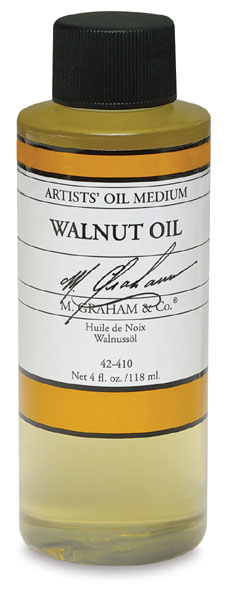At first I wanted to write about different types of oils and solvents more, but then I realized that the size of the article would become tremendous. So I’ve made a tough decision to concentrate only on general features of oils and solvents. Next week I will (hopefully) write the second part of the article.
Anyway, let’s leave this long entry and get back to the theme.
Most of the beginner artists I know use pure oil as a thinner. In most cases, it’s sunflower oil – it is easily accessible and cheap. However, if you want your works to last longer the choice of sunflower oil is pretty bad, because, eventually, this oil softens (in 5-10-15 years), becomes tacky and blacken the painting. It can be used only if you thought of it in advance (6-12 month before) and maintained it in a transparent jar in a sunny place. Sounds a bit unrealistic.
 |
| Walnut oil by M. Graham |
Oils
In oil painting artists use drying oils, derived from the various seeds, which are related to vegetable fats – linseed, poppy and nut oils. Poppy and Nut oils are more transparent, but also more expensive than linseed. Be aware, olive, coconut and castor oils are non-drying and cannot be used in painting.
Pros
- has no scent- makes paint ductile
- slows drying (it's both good and bad depending on your needs)
Cons
- linseed oil has a tendency of yellowing- excess of oil leads to cracking
- if there is too much oil after some years the drops of oil may exude on the canvas and harden as a yellow drops
If you use the oil as a thinner the approximate time of drying is around 24-48 hours. It is suitable for those artists who like to paint over wet paint, so you can come back to the painting the next day and the layer of paint will be still “alive”.
Thinners/Solvents
If you want to thin the paint it's a good idea to use something that will evaporate and leave no trace in paint. Artists use turpentine, turpenoid, pinene, white spirit and others for that.
Pros
- paint dries quicklyCons
- evaporates on the air- under the air and light turpentine thickens and loses the color. It should be stored in a closed metal jars or dark glass bottles, filled top to bottom
- paint become matte
- odorless versions are usually expensive
- paint becomes not durable and may darken over time
- some artists consider the downside the fact that pure solvent as a thinner is too liquid, leaky, and spreads easily
Varnishes
 |
| Dammar is the most popular varnish, but be careful - it is not recommended to use as a medium |
Pros
- helps the paint to dry evenly and simultaneously- decreases the dullness
- increases the ability of one layer of paint to adhere to another
Cons
- cannot be used alone, because it makes the paint layer too fragile- not elastic
Pure varnish as a thinner is rarely used also because it dries too quickly.
Mixture
 |
| Painting Medium by Daler-Rowney. Made of Linseed Stand Oil, White Spirit and Oil of Spike Lavender |
3-in-1 mixtures of oil, solvent and varnish (or 2-in-1 - oil+solvent) are considered to be the best thinner for oil paints because they unite all the advantages of components – for example, varnish and oil neutralizes the loss of the binder of the paint (prevent the dullness) and keep the intensity of colors.
Sounds like a perfect variant, but some artists warn that varnishes and oil paints have a very different drying speed so mixing them may cause the cracking (craquelure effect).
Artists use different proportions, but the most common starting point is 1:1:1 – use the equal parts of the ingredients. Depending on the purpose you can change the proportion.
There are also premade (ready-made) mixtures. It is generally considered that these mixtures are made from the cheap and low-quality ingredients, however, they can be a good choice for a beginner artist. But don’t buy mixtures from the unknown companies – choose well-known manufacturers, who have quality standards.



No comments:
Post a Comment